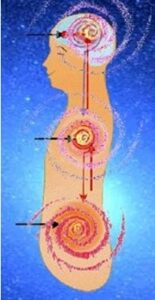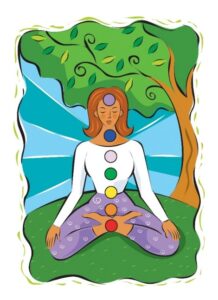Further Energy Centre Breathing and Awareness Techniques
In this lesson, we will explore deeper breathing and awareness techniques to enhance your connection with the body’s energy centres.
1. Exercise #1: “3 Minds into 1” Technique
According to the Taoist system, the different tan tien’s have different purposes. The role of the upper tan tien is as an observation centre, housing the “observing mind”; the role of the middle tan tien is a feeling centre, housing the “feeling mind”, and the role of the lower tan tien is an awareness centre, housing the “pure awareness mind”, in other words, an aspect of ourselves not encumbered by thought or emotion.

[Image from Mantak Chia]
The following technique is a meditation to harmonise these 3 aspects of ourselves.
Practice Guide
Please watch the video below for this practice.
[INSERT VIDEO]
A written description of this exercise can be found at the “Exercise Files” tab. After you have completed the exercise, spend a moment to observe internally, and then write down in your course journal how you feel.
2. Walking with attention at the Lower tan tien
This exercise helps cultivate a deeper connection with the lower tan tien by allowing it to guide your movement as you walk. It enhances grounding, balance, and the ability to move with energy awareness.
Start with exercise #1 above to establish a focus at the lower tan tien, and then begin to walk around the room, or any outdoor area, maintaining at all times your focus at that centre.
Try to allow that centre to lead the walk – so that where you walk is determined by that centre.
Practice Guide
More detailed instructions for this exercise can be found in the Exercise Files tab, in the document entitled: “Further Energy Centre Breathing and Awareness Exercises”.
This exercise deepens awareness of your centre of gravity and energy, leading to more fluid, balanced movement.
Walking in this way enhances Qi flow, mindfulness, and intuitive awareness of your body’s natural rhythms.
Over time, this practice can improve stability, presence, and connection with your internal energy system in everyday life.
Try incorporating this into your daily walks and notice how it transforms your movement and awareness!
After you have completed the exercise, spend a moment to observe internally, and then write down in your course journal how you feel.
3. Chakra breathing
This exercise is a powerful tonic for the whole body, healing and energising the body at a deep level. In this exercise, we use an 8-chakra system.
Benefits of this exercise:
- Enhances energy awareness and balance throughout the body.
- Deepens focus, relaxation, and inner harmony.
- Helps clear blockages and promotes the free flow of Qi.
This practice can be done daily to cultivate a greater sense of connection with your energy centres.
CAUTION: According to Yogic belief, the chakras become encumbered by trauma events in one’s life, and limited beliefs that result from those events. When working with the chakras consciously, such as with this exercise above, we charge the area with energy and encourage those memories to surface. The longer we place our attention there, the more energy we are adding. Chakra breathing therefore can result in emotional release, with the pent-up emotions coming to the surface. This is good, if this does happen, let the energy inside be expressed, and do not try to stop or prevent it. If you feel to cry, then allow it, if you feel to shout, then do it. Whatever surfaces, allow it to be, express yourself freely.
To help in the processing of what emerges, you may benefit by talking about the experience to a close friend or counsellor, or writing down everything that transpired.

Practice Guide
Please watch the video below for this practice.
[insert video]
A written description of this exercise can be found at the “Exercise Files” tab. Please write in your Course Journal after you have completed the exercise.
